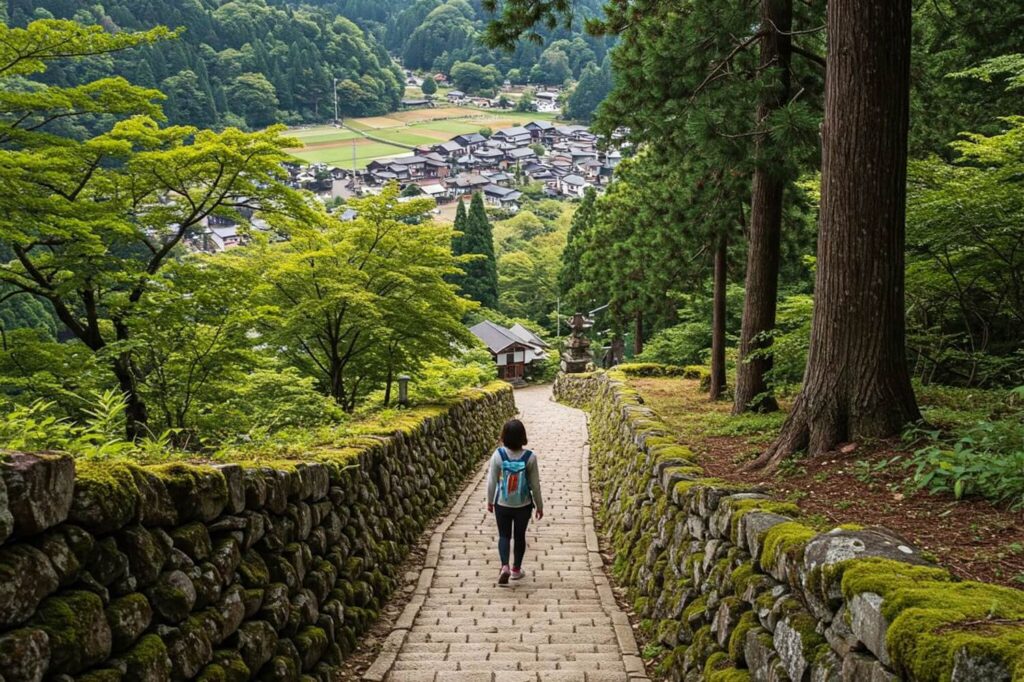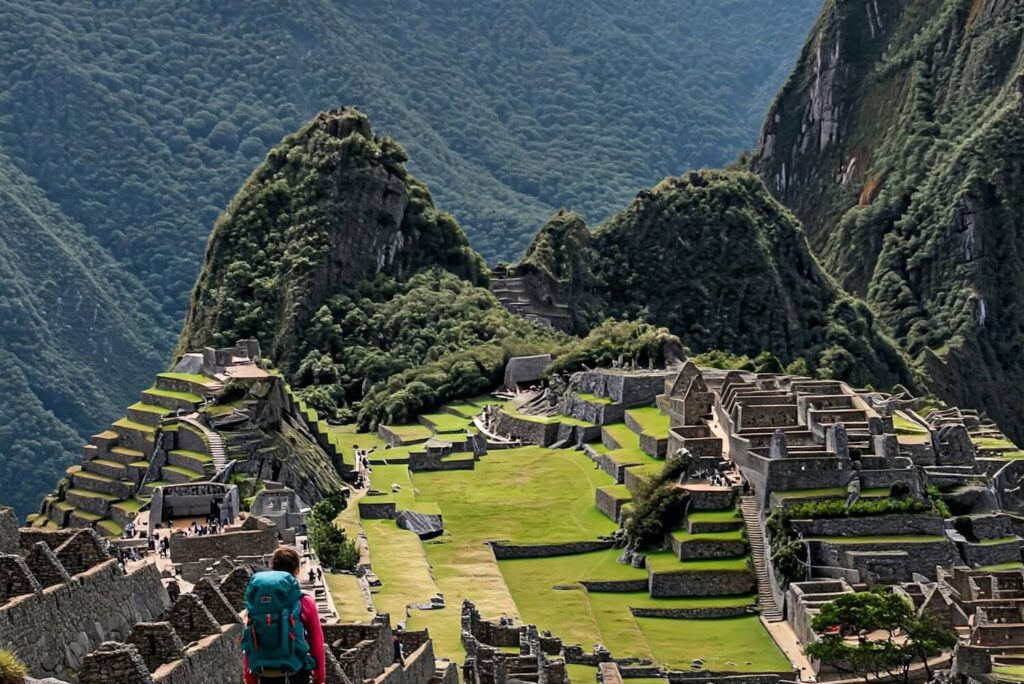Introduction to the Nakasendo Trail
The Nakasendo Trail, a historic route established during Japan’s Edo period, is one of the five principal routes used for travel and trade during this time. Stretching approximately 540 kilometers (335 miles), it provided a vital link between the imperial capital of Kyoto and the shogunal capital of Edo, now known as Tokyo. This trail was not merely a pathway for foot travelers; it served as a channel for cultural exchange, commerce, and the dissemination of information across regions of Japan.
During the Edo period, travel was predominantly undertaken on foot. The Nakasendo Trail facilitated this movement with its well-used way stations called “shuku,” which allowed travelers to rest and resupply. These post towns were critical to the interactions that took place among merchants, samurai, and commoners, fostering a sense of national unity and contributing to the socio-economic landscape of the era. Along the trail, travelers could encounter diverse local cultures, making it a melting pot of traditions and practices that highlighted Japan’s rich heritage.
While the Nakasendo Trail is an important historical artery, it is also renowned for its picturesque landscapes and well-preserved post towns, such as Magome and Tsumago. These towns offer a glimpse into the past, with traditional wooden buildings and scenic views of the surrounding mountains. Today, the trail is not only a route for hiking enthusiasts but also a living museum that enables visitors to step back in time and explore the path taken by countless travelers centuries ago.
The enduring significance of the Nakasendo Trail lies in its dual role as a facilitator of commerce and a conductor of cultural exchange. This historical trail remains a testament to Japan’s rich past and continues to captivate those who seek to understand the foundational aspects of its society and culture.
Historical Context of the Trail
The Nakasendo Trail, one of Japan’s notable historical routes, was established during the Edo period (1603-1868) and served as a vital artery connecting Kyoto and Edo (modern-day Tokyo). Spanning approximately 534 kilometers, the trail facilitated not only transportation but also the exchange of culture, commerce, and political power between the two significant cities of the time. As a major thoroughfare, the Nakasendo was integral to the travel of samurai, merchants, and common travelers who sought to navigate the archipelago’s mountainous terrain.
During the Edo period, the Tokugawa shogunate instituted a policy of seclusion, which led to the enhancement of domestic trade and travel systems, including the development of the Nakasendo Trail. This route was unique compared to other major paths, such as the Tōkaidō, as it wound through the mountainous regions of central Japan, offering travelers various landscapes—from deep forests to picturesque post towns. The trail significantly influenced the growth of these post towns, known as “shukuba,” which emerged as essential stopping points for weary travelers. These towns provided accommodation, meals, and other necessary services, effectively becoming the backbone of the trail’s infrastructure.
The interactions along the Nakasendo were diverse, showcasing the seamless blending of social classes. Samurai would travel along the Nakasendo carrying their family crests, while merchants transported goods, thus contributing to the vibrant local economies. The trail not only facilitated the movement of people but also played an important role in the dissemination of culture, ideas, and goods throughout Japan. This historical context underscores the trail’s significance, highlighting how it shaped travel and community life during a key period in Japanese history.
Key Post Towns Along the Trail
The Nakasendo Trail, an ancient route connecting Kyoto and Edo (modern-day Tokyo), is lined with historical post towns that have been well-preserved over the centuries. Among these, Magome, Tsumago, and Narai stand out as exemplary representations of traditional Japanese culture and architecture.
Magome is the starting point for many travelers venturing into the Nakasendo. This charming post town is known for its steep pathways flanked by wooden houses, tea shops, and art galleries. The town’s architecture, distinctively simple with wooden beams and tiled roofs, embodies the Edo period’s aesthetic values. Visitors can enjoy local specialties, such as ‘ksen-ryokucha’ or green tea, while soaking in the stunning views of the surrounding mountains. The preservation of Magome’s historical charm provides a glimpse into the past, making it a delightful stop along the adventure.
Further along the trail lies Tsumago, another well-preserved post town that captures the essence of this historical route. Designated as an Important Preservation District for Groups of Traditional Buildings, Tsumago features unpaved streets, traditional inns, and a rich history that dates back to the 17th century. This town is well-known for its strong commitment to preservation, with efforts to maintain its original structure and ambiance. Visitors can explore various shops and historic buildings while enjoying the tranquil atmosphere that echoes the simplicity of rural Japan.
Lastly, Narai, often referred to as ‘Narai-juku’, was one of the wealthiest post towns during the Edo period. It boasts a stunning row of well-preserved wooden houses and remains a significant center for traditional crafts, including the making of lacquerware. Travelers can immerse themselves in the unique local culture by visiting the town’s small museums or attending workshops centered around these traditional crafts. Narai’s engaging history and handcrafted goods encapsulate the essence of the Nakasendo, offering an authentic experience of Japan’s rich heritage.
The Walking Experience on the Nakasendo Trail
The Nakasendo Trail, renowned for its blend of history and natural beauty, offers a unique walking experience that attracts hikers from around the globe. Stretching approximately 534 kilometers, this ancient route connects Kyoto and Edo (modern-day Tokyo), allowing visitors to traverse through idyllic landscapes rich in cultural significance. The trail is divided into multiple segments, usually covering around 8 to 14 kilometers per day, making it accessible for hikers of varying fitness levels.
As walkers embark on their journey, they encounter a diverse array of landscapes that range from towering mountains and serene forests to picturesque rice paddies and quaint post towns. The Nakasendo Trail has been preserved in many areas, allowing trekkers to appreciate well-maintained paths, historic wooden bridges, and traditional inns that echo the spirit of the Edo period. Trail conditions vary, with some sections being more rugged and requiring proper footwear and preparation. However, much of the route is gentle enough for leisure walkers, providing an opportunity to immerse oneself in the tranquil environment.
Beyond the physical exercise of hiking, the mental benefits are equally significant. Walking through such an enchanting landscape provides a sense of peace and an escape from the hustle and bustle of modern life. The rhythmic motion of walking, combined with the fresh mountain air and the sounds of nature, enhances relaxation and mental clarity. Hikers often find themselves more attuned to their surroundings, fostering a deep appreciation for the natural beauty of Japan. As one traverses the Nakasendo Trail, the experience becomes not just a physical journey but a profound connection with history and nature.
Cultural and Culinary Highlights
The Nakasendo Trail offers a unique opportunity to immerse oneself in Japan’s rich cultural heritage and culinary traditions. As one traverses this historical route, the essence of Japanese culture is manifest in various forms, from local customs to traditional crafts that have been preserved through generations. Each post town along the trail serves as a microcosm of regional traditions, inviting travelers to partake in the local way of life.
A notable aspect of the cultural experience on the Nakasendo Trail is the warm hospitality extended by the local residents. Customs such as “omotenashi,” the Japanese concept of selfless hospitality, are prevalent. Visitors may notice this dedication to service through shared meals in traditional lodgings known as “ryokan.” Here, travelers are often treated to a multi-course kaiseki dinner, showcasing seasonal ingredients that reflect the area’s agricultural bounty. This culinary practice pays homage to the importance of food in Japanese culture, particularly in nurturing the deep connection between nature and sustenance.
Additionally, artisanal crafts can be explored in the post towns. Traditional crafts such as indigo dyeing, pottery, and weaving are integral to the cultural fabric of the region, often available for visitors to observe and even participate in. These workshops not only provide a hands-on experience of Japanese craftsmanship but also reinforce the idea of preserving history through tangible art forms. The intricate attention to detail and the rituals involved in creating these crafts serve as a reminder of the time-honored practices that characterize rural Japan.
Furthermore, regional specialties, including soba noodles, pickled vegetables, and sweet treats like “kuzumochi,” are essential to the culinary landscape along the Nakasendo Trail. Each dish tells a story, offering insights into the local ingredients and their seasonal availability. In conclusion, the cultural and culinary experiences along the Nakasendo Trail are not merely supplementary; they form the very essence of what it means to walk this historic path, deeply connecting visitors to Japan’s rich legacy.
Preparing for the Hike: What to Pack
Embarking on the Nakasendo Trail is an exhilarating experience that requires careful planning and preparation to ensure a safe and enjoyable journey. Proper packing is essential, and having the right gear can significantly enhance your hiking experience in this historical region. First and foremost, start with a durable, comfortable backpack that fits your body well; a capacity of 40 to 60 liters is typically sufficient for a multi-day hike. It is advisable to bring essential items such as a hydration system or water bottles, along with a portable water filter or purification tablets to ensure a continuous water supply.
When it comes to clothing, consider the season in which you plan to hike the Nakasendo Trail. For spring and autumn, layering is key, as temperatures can fluctuate. A moisture-wicking base layer, an insulating mid-layer, and a waterproof outer layer will provide comfort across varying weather conditions. During summer, lightweight, breathable clothing is preferable, while in winter, thermal layers and insulated jackets will be necessary. Furthermore, do not forget to pack a sturdy pair of hiking boots with good ankle support and a grip sole, as well as a pair of sandals for relaxation in the evenings.
Other essentials include a first aid kit, a multi-tool or knife, a reliable map or GPS device, and personal identification. Additionally, it is wise to carry energy bars or trail mixes to maintain energy levels throughout the hike. To stay comfortable while navigating the Nakasendo Trail, invest in high-quality trekking poles, which will provide support and stability on uneven terrain. Lastly, be sure to understand safety precautions, such as following trail markers, hiking with a partner, and being aware of local wildlife. Good preparation will not only enhance your hiking experience but also allow you to fully immerse yourself in the stunning beauty and history of the Nakasendo Trail.
Fauna and Flora Along the Trail
The Nakasendo Trail offers an extraordinary opportunity for hikers to engage with a rich tapestry of biodiversity, showcasing an array of plant and animal species that thrive in this historically significant region. As you traverse the trail, you may observe various altitudinal zones, from the lush foothills to the higher mountain areas, each home to unique ecosystems and wildlife. The trail meanders through a mix of deciduous and coniferous forests, which provide a habitat for numerous species, making it an excellent destination for nature enthusiasts and ecologists alike.
Among the notable flora, one can find the Japanese maple (Acer palmatum), known for its vibrant foliage, especially during the autumn months. Additionally, the trail is dotted with cherry blossom trees (Prunus serrulata), which bloom in spring, creating picturesque landscapes that attract both travelers and native wildlife. Various ferns and mosses also thrive in this moist, temperate climate, contributing to the lush vegetation that blankets the region.
The fauna along the Nakasendo Trail is equally diverse. Hikers may have the chance to spot the Japanese macaque (Macaca fuscata), often seen foraging among the trees. Additionally, the trail is home to numerous bird species, such as the varied tit (Parus varius) and the Japanese green woodpecker (Picus awokera), which can be heard and seen flitting among branches. These species, alongside others like deer and foxes, play essential roles in maintaining the ecological balance of the region.
Given the trail’s historical significance and the continued preservation of its natural environment, the Nakasendo Trail stands as a testament to Japan’s commitment to conserving its rich biodiversity. As visitors explore this scenic route, they not only experience the beauty of Japan’s natural landscapes but also gain insight into the importance of ecological preservation for future generations.
Personal Stories: Hikers’ Experiences
The Nakasendo Trail, known for its scenic beauty and historic significance, has inspired countless hikers to embark on a journey through Japan’s rich past. Many who have traversed this ancient route share profound personal stories that vividly echo their experiences and the lasting impressions left on their hearts and minds. Hikers frequently recount the emotional connections established with the landscape, from the quiet solitude of the mountains to the vibrant tranquility of the traditional post towns.
One hiker, Sarah, reflects on her journey with a sense of reverence. Having walked the trail during the cherry blossom season, she describes the cascading petals as a symbolic renewal of life. “Each step felt like a reminder to cherish the fleeting moments,” she shares, emphasizing how the natural beauty of the trail facilitated a spiritual connection to nature and self. This sentiment is common among those who traverse the Nakasendo, as the combination of rigorous physical activity and the surrounding picturesque vistas often leads to moments of introspection.
Another hiker, Kenji, recounts a poignant encounter with a local craftsman in the town of Tsumago. Engaging in conversation, he learned about the traditions of his ancestors and the preservation of cultural practices along the trail. Kenji stated, “It was a revelation to understand that I was walking not just through a landscape, but through the collective memory of my people.” This illustrates how the Nakasendo Trail serves as a conduit for connecting with history, fostering both personal growth and cultural appreciation.
These personal testimonies illustrate the diverse experiences of hikers on the Nakasendo Trail, fostering a deeper appreciation for the journey, not merely as a physical endeavor but also as a path toward self-discovery and emotional enrichment. To walk the Nakasendo Trail is to step into a narrative that resonates across time, ultimately enriching one’s understanding of Japan’s heritage and their place within it.
Conclusion: The Lasting Legacy of the Nakasendo Trail
The Nakasendo Trail, which connects Kyoto and Edo (modern Tokyo), is not just an ancient route but a significant cultural heritage that continues to resonate in contemporary Japan. This historic pathway, once trodden by samurai and merchants, now serves as a conduit between the past and the present. It offers a unique opportunity for modern walkers to immerse themselves in the rich tapestry of Japan’s history while experiencing the natural beauty of the countryside. The trail is a vivid reminder of the country’s storied past and the traditions that have shaped its identity.
In recent years, there has been a revitalized appreciation for the Nakasendo Trail, which has become a focal point for cultural preservation efforts. The charming post towns along the route, such as Magome and Tsumago, have maintained their traditional architecture and practices, drawing visitors eager to engage with Japan’s history. These towns not only exemplify the architectural styles of the Edo period but also serve as models for sustainable tourism. This emphasis on preserving cultural heritage allows travelers to experience an authentic glimpse into the lifestyles of those who once traversed the trail.
Beyond cultural preservation, the Nakasendo Trail also promotes personal discovery. Walking along its paths, visitors often find themselves reflecting on their own journeys and experiences. The act of walking becomes a meditative process that encourages mindfulness and connection with both the environment and one’s inner self. The legacy of the Nakasendo Trail is thus twofold; it fosters a deeper appreciation for Japan’s history while simultaneously allowing individuals to engage in reflection and renewal. As a bridge between the historical and the contemporary, the Nakasendo Trail continues to enrich the lives of those who walk its path, embodying a timeless narrative of exploration and discovery.



